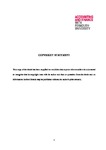DETERMINANTS AND CONSEQUENCES OF CSR DISCLOSURE QUANTITY AND QUALITY: EVIDENCE FROM SAUDI ARABIA
| dc.contributor.supervisor | Hussainey, khaled | |
| dc.contributor.author | Alotaibi, Khaleed | |
| dc.contributor.other | Plymouth Business School | en_US |
| dc.date.accessioned | 2016-08-18T12:11:10Z | |
| dc.date.available | 2016-08-18T12:11:10Z | |
| dc.date.issued | 2016 | |
| dc.identifier | 10416096 | en_US |
| dc.identifier.uri | http://hdl.handle.net/10026.1/5332 | |
| dc.description.abstract |
This study aims to examine the determinants and consequences of the quality and quantity of Corporate Social Responsibility (CSR) disclosure of Saudi non-financial firms. The objectives of this study are as follows: firstly, to measure CSR disclosure quality and quantity; secondly, to identify the determinants of CSR disclosure quality and quantity; and thirdly, to examine the impact of CSR disclosure quality and quantity on firm value. The study uses a sample of 171 observations of non-financial firms listed on the Saudi stock market between 2013 and 2014. It develops two CSR disclosure indices to measure the quality and quantity of CSR disclosure in order to identify their determinants and consequences. This research complements and extends the work of Hasseldine, Salama and Toms (2005) by measuring the quantity and quality of CSR disclosure and examining their impact on firm value. This study follows Beest et al. (2009) and Charkoun and Hussainey (2014) to measure CSR disclosure quality by capturing the qualitative attributes of information quality as defined in the conceptual framework of the IASB (2010). It also uses a CSR disclosure index to measure the quantity of disclosure, following prior research (e.g. Hackston and Milne, 1996; Hall, 2002). The study finds that Saudi Arabian firms provide a high level of CSR disclosure quantity; however, the quality of disclosure was relatively low. The study finds that CSR disclosure quantity was positively associated with board size and the size of the audit committee. However, it is negatively associated with the percentage of governmental ownership and the size of remuneration committees. On the other hand, the quality of CSR disclosure is positively associated with board size and the percentage of managerial ownership. However, it has a negative association with the percentage of independent directors. The findings indicate that the drivers of CSR disclosure quantity differ from the drivers of CSR disclosure quality. In terms of the consequences of CSR disclosure, this study examines the impact of CSR disclosure on firm value. The study uses three proxies for firm value: Tobin’s Q ratio (TQ), Return on Assets ratio (ROA) and Market Capitalisation (MC). The analysis shows a positive association between CSR disclosure quality and quantity and MC. However, this study did not find the same results when TQ or ROA were used as proxies for firm value. This suggests that both CSR disclosure quantity and quality have the same impact on firm value. However, the significance of this impact depends on the proxy used for firm value (e.g. MC, TQ or ROA). This study highlights the implications of the quality and quantity of CSR disclosure for users of annual reports, both in Saudi Arabia and other countries. One of these implications is that CSR disclosure can affect the value of firms, which means that companies need to pay more attention to CSR activities. Furthermore, the disclosure of these activities may improve the relationship between the firm’s reputation and its stakeholders. This study points to the importance of discussing these issues and to the fact that doing so is a responsibility that companies hold towards society. | en_US |
| dc.description.sponsorship | Saudi cultural Bureaue | en_US |
| dc.language.iso | en | en_US |
| dc.publisher | Plymouth University | en_US |
| dc.title | DETERMINANTS AND CONSEQUENCES OF CSR DISCLOSURE QUANTITY AND QUALITY: EVIDENCE FROM SAUDI ARABIA | en_US |
| dc.type | Thesis | |
| plymouth.version | Full version | en_US |
| dc.identifier.doi | http://dx.doi.org/10.24382/3884 | |
| dc.identifier.doi | http://dx.doi.org/10.24382/3884 |
Files in this item
This item appears in the following Collection(s)
-
01 Research Theses Main Collection
Research Theses Main


